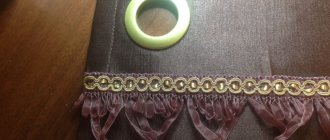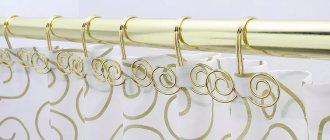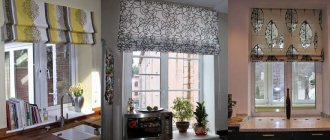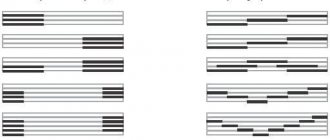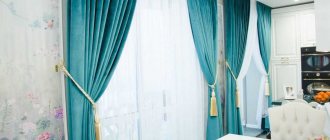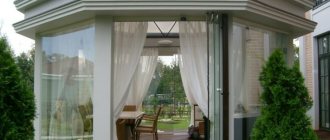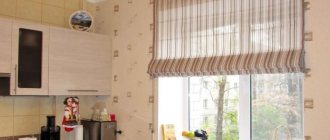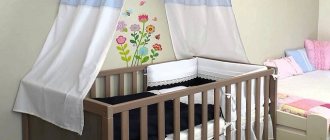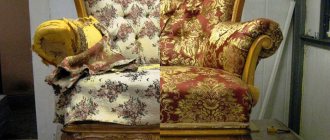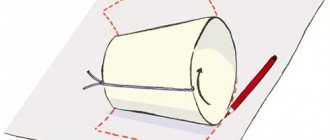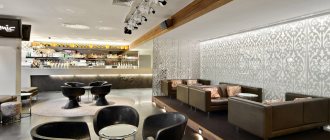Features of the Italian style
Curtains in the Italian style appeared in Ancient Rome, but gained wide popularity in the 18th century. With their help, rich people decorated both window and doorways. The presence of such decor indicated the good taste and high position of the owner in society.
Such curtains decorate the room more than protect it from prying eyes. They have a special design: 2 vertically positioned canvases, which in their upper part are overlapped, end-to-end, or located next to each other, reaching to the floor.
The tiebacks are located at the top, and not at the level of the window sill, which allows the canvas to be lifted diagonally in semicircular folds.
Most often, such curtains do not move, so you will have to hang additional curtains to protect from the sun.
Kinds
The curtains in question are presented in 2 models:
- Classic. They are in one position and only cover the window a little. The canvases are fixed in a given position using cords attached to the wall or cornice.
- Sliding. Using strands or a rack and pinion mechanism, they are gathered into folds. They are controlled by tensioning or relaxing the cord.
In addition, the models differ in the shape of the folds: semicircular or cylindrical. When designing, both the selected image and a combination of 2 colors are used. Accessories in the form of Maltese crosses, rosettes, bows, etc. are required.
Exquisite curtains: Italy is our guest
Italy has always been famous for the quality of its products, and if you pay attention to the curtains, then in every line of the product you can see the nobility of lines, sophistication of style and laconicism. Italian curtains are a classic decor option and can complement the decor of any bedroom, living room or add a touch of nobility to the kitchen.
What is special about Italian curtains:
- They cannot be pulled apart completely - the design of these curtains has tiebacks located at a height that allow such curtains to be assembled diagonally;
- Such a curtain may well reach the floor or not reach it by 1 cm;
- Elegant ruffles can run along the top of the product, thanks to the curtain tape, which emphasizes the beauty of the folds;
- The defining features of Italian textiles are considered to be noble lines and aristocracy.
You can raise such curtains thanks to ribbons and cords, which are located on the wrong side of the canvas. These products are also distinguished by diagonal or canvases connected in the center of the cornice, which, in fact, do not allow the structure to be fully revealed.
Thanks to the presence of high-mounted tiebacks, such curtains are perfect for high window openings or arches. In this case, the garters themselves can be located both on the wall and on the cornice. The lower the risers, the darker the room.
Curtains from Italy are also suitable for windows where, for some reason, side curtains cannot be hung.
The luxury of such products is emphasized by additional accessories: brocade or satin ribbons, heavy cords, tassels...
It is better not to hang Italian curtains in a room with low ceilings!
Fabrics and colors
Classic Italian curtains used to be made from dense and thick fabrics - satin, brocade, velvet. Later, the range expanded: now they are made from cotton, linen, organza, chiffon, and artificial fabrics. To weight light models, special weights are used.
If previously the canvases were plain, often brown, green or burgundy, now there are no such restrictions. Much depends on the choice of the customer.
Often different designs are applied to Italian fabrics. You should not choose a large image that will be distorted in the folds.
Small designs are suitable: floral patterns, stripes, checks, etc. Curtains should fit harmoniously into the interior of the room.
How to choose fabric
Classic Italian curtains were made from elite, dense, heavy and easy-to-drape fabrics based on natural silk fibers: velvet, brocade, satin, silk. Today, the choice of fabrics for sewing them has expanded significantly. They can be not only silk, but also linen, cotton, mixed, artificial and not necessarily dense and heavy.
Modern models can even be sewn from veil, organza and chiffon. The main condition for fabric is the ability to form soft, expressive folds. And to make the coattails of such canvases look beautiful, the canvases are placed on a lining or special weights are sewn onto their bottom.
Colors and prints can also be very different. Initially, for such curtains, plain textiles were chosen in deep, saturated colors: blue, burgundy, green, brown. Now the choice of the shade of Italian curtains depends only on personal preferences, and the fabric can also have a pattern.
Of course, all this should look harmonious in the interior. In addition, you should take into account that a large pattern will “break” in the folds, so if you like printed curtains, choose a fabric with a small pattern, preferably a floral one. A small check or stripe would also come in handy.
Traditionally, Italian curtains were made from fabric in rich shades of red, green, beige and blue. To prevent the window from looking too dark, the main curtains were shaded with curtains of the same, but very diluted color.
Decoration methods
The presence of decor helps make Italian curtains even more original and attractive.
For this we use:
- symmetrical folds, which have a semicircular or cylindrical shape and are regulated by a lifting mechanism;
- printed ornament;
- an original combination of several shades of the same color;
- contrast edging;
- lambrequins;
- decorative elements (bows, ribbons, tassels, fringe, rosettes, cords, etc.).
Italian curtains - elegance as it is!
Italian curtains are the standard of high quality, grace and elegant appearance. This type of torus is in great demand and popularity all over the world. They stand out for their originality and unusual appearance, for this reason they can decorate almost any type of interior, giving it a distinct touch of aristocracy!
A characteristic feature of this type are the folds that are located on the upper edge of the product. They look special, so it is almost impossible to confuse them with similar curtains of other types. Such folds can be of absolutely any shape, from cylindrical to semicircular, but the main thing remains the clarity of the lines and symmetry, which is due to the presence of a special lifting mechanism with slats. And the branded (sorry for the tautology) folds are formed by special curtain tapes, which are a special braid. Thanks to their presence, the folds are smooth and symmetrical, and also allow you to effectively emphasize the unique shape of the curtains.
The lifting mechanism is another unique feature of the curtain. Their rise looks quite elegant, and it is ensured thanks to special cords and ribbons, which are located on the wrong side of the product. The curtains are placed diagonally. Thanks to the “management” of the cords, they are able to elegantly drape the window opening, allowing the folds to diffuse the sun's rays, effectively falling down. Decor can be used, however, options without it are no less in demand from buyers.
Design features
Italian curtains do not rise or move until the very end, which is one of the distinctive features of this type. Their lower part lies neatly on the floor, while the vertical panels are attached to each other from above. Special grabs securely fix them in an area that is slightly below the level of the window sill.
There are two subspecies of Italian curtains:
- Stationary, which is classic (or standard). It involves fixing the canvas diagonally using: hooks, grabs or cords that are placed directly on the wall or cornice. In this case, curtains are used to regulate the illumination of the room. But the review itself remains half open.
- With rack and pinion mechanism. Sliding models have cords passing through rings located inside (along the edges of the cornice itself). Operating such a mechanism is quite simple. To do this, it is enough to tighten or loosen the canvases to the desired level, and then fix them. However, this type is characterized by the fact that part of the view remains open.
Types of materials
Looking ahead, it is worth noting that a lot of material is required to create Italian curtains. This is due to the fact that long curtains that lie slightly on the floor look very presentable.
Considering that this type is characterized by an abundance of folds, it is necessary to select a heavy fabric so that it lends itself better to draping. If a lighter fabric is chosen, you can use additional decorative elements to make it heavier: weights or the lining required for the lower edge of the curtain.
As mentioned above, the fabric should be wrinkle-friendly, so lightweight fabrics with good drape are ideal for this purpose. Today you can often find options made from veil, and less often - satin.
Advantages
Italian style curtains boast a lot of positive aspects. First of all, these include:
- Practicality. Curtain materials do not wear out (and therefore do not lose their properties and beauty of appearance), since they need to be moved quite rarely.
- The drapery of such curtains allows you to hide the not very beautiful cornice, as well as errors that are typical for a window opening.
- Ease of use. Stationary models do not require any action on the part of the owners at all, while sliding models cover the window opening without any problems when the tiebacks are released.
- They make it possible to visually expand or “raise” the window, and from the outside they look like designer ones.
- Versatility. Such curtains will fit perfectly into any interior, and will also harmonize with any shape of window openings, from cylindrical to arched.
Suitable color scheme
When choosing the color of Italian curtains, take into account the design of the room in which they will be located.
The following colors are popular now:
- brown – creates coziness;
- green – suitable for the kitchen, bringing freshness and energy to it;
- burgundy - gives the room an expensive and luxurious look;
- yellow – helps make the design brighter and more cheerful;
- beige - helps to visually enlarge the space, therefore it is often used in small rooms;
- blue - makes the room fresh, airy and light, creates a relaxed atmosphere;
- lilac – brings calm and tranquility to the room.
What fabric to choose for Italian curtains
Italian curtains differ from others in their noble folds and tiebacks, and to make this image of aristocracy as bright as possible, we recommend using only high-quality and suitable materials.
When draped, heavy, weighty fabrics form even, symmetrical folds in the upper part of the Italian curtains, and when tacked, they allow the fabrics to elegantly hang over the floor or even lie slightly on it.
The best fabrics for Italian curtains are: thick satin, velvet, cotton, linen, basit and brocade. Many craftsmen are experimenting with light fabrics such as veil or organza.
Italian curtains made of light fabric are often made double or have a weight suspended at the bottom.
The photo shows a double composition of tulle of an Italian cut and a classic one made of light voile fabric
In what interior styles can it be used?
A large assortment of Roman blinds allows you to use them in interior design in different styles.
Classical
This style is characterized by luxury and rich decor of all elements used, including curtains. To beautifully decorate a window in a classic style, Italian curtains are made from thick fabric, such as jacquard or brocade. To complement the window design, forged decor is used on the ends of cornices, etc.
Modern
Due to their functionality and elegant simplicity, such curtains are actively used in interior design in modern homes. The ability to diffuse sunlight or darken a room allows them to be used in almost any room, such as the kitchen, living room, bedroom, and even the balcony or bathroom.
They are often complemented by curtains and translucent curtains.
Baroque and Rococo
These styles are characterized by the use of complex drapery, curved lines and multi-layered textiles. When decorating a room in the Baroque and Rococo style, use curtains made from heavy fabrics such as gabardine or velvet, as well as brocade, silk or satin, because... they drape well. In addition, additional elements are popular - tassels, tiebacks, lambrequins, etc.
Living room
Typical Italian curtains are ideal for richly decorated living rooms with carved solid wood furniture.
wall decoration
Decorating one wall of the living room is a common technique for using fabrics in small rooms with low ceilings. This allows you to bring traditional Italian paintings into almost any interior.
oakandteak
Double protection
The reluctance to disrupt the smooth lines of the curtains leads to a search for options for protection from light on a bright sunny day. An example is the combination of matte tulle fabric and classic Italian fabrics.
curtains.by.signature
Corner window with lambrequin
The beneficial theme of placing Italian curtains was embodied in the corner window opening. This option is simple in design with a double rigid lambrequin with a slight change in the design of the cornice.
proluxe_interiors
Round living room
The desire to completely get away from the walls, hiding them behind fabric, creates the illusion of a continuous panoramic window with a huge flow of light into the room. Wide classic canvases, gathered with tiebacks into folds, are made of fabric that contrasts with the overall color scheme of the room.
alyasmeenfurnitureoffical
curtains.by.signature
Narrow room
Even a small room can be put in order if you show a little imagination and cover the end wall with Italian curtains. A good design solution would be to use second dark curtain panels that have the same color as the furniture upholstery.
curtains.by.signature
Wide window
You don’t need to invent anything to decorate a wide window in the living room. It is enough to take a light beige fabric, sew rings to it, sew the side panels with a single wide ribbon and hang all this splendor on a long cornice above the window.
royal_curtain_and_blinds_
curtains.by.signature
Three windows
The large living room, which has three separate windows, is well decorated with curtains in the same style, which must be continued in the furniture and wall decoration, matching them with the colors of the fabrics.
questmek.interiors
Beige and gilding
The design of large, richly furnished living rooms is thought out to the smallest detail. If gold is used in the interior, then it will be necessary to use a beige color, which does not distract attention from the shine of the metal. Any other colors will disrupt the harmony of wealth and nobility.
drapes_designers
parde_ronas
Coffee color in a black and white living room
The abundance of black and white would make the room boring and uncomfortable, if not for the Italian coffee-colored canvases with gold fringe. The room immediately gets a finished, noble look, and soft folds in the fabrics brighten up the monotony of the short curves of the furniture.
drapes_designers
curtains.by.signature
mafco_decordubai
Dark living room
Windows facing north or northwest provide little light into the room, and the abundance of dense fabrics on the windows can reduce illumination to almost zero. The solution was found in a glossy floor finish and the choice of a light, noble color of Italian curtains. Now even the complete cutting off of daylight is not capable of disturbing the internal harmony of the room.
deutscheshausofficial
__design__room__
Chic classic
Real Italian curtains, through the efforts of an experienced designer, can decorate an expensive living room with Baroque style furniture. The wide border on the side panels can completely cover the window when the arms are released. A three-piece soft fabric pelmet descends from under a wide cornice that runs along the entire perimeter of the ceiling, and its ends form classic overhangs on both sides of the curtains.
deutscheshausofficial
What rooms are they suitable for?
Although Italian curtains are suitable for many interior styles, they are most often used in the classic design of large rooms with tall and narrow windows, such as exhibition halls, restaurants, museums, etc. For standard rooms, it is better to choose the length of the canvas slightly below the window sill.
Living room
The use of Italian curtains in the living room helps make this room solemn and festive. Often, to create additional comfort, such curtains are complemented with light tulle. In a large room, it is better to use curtains that are floor-length. As an additional decor, it is worth using lambrequins and lush tiebacks. If the living room is small, then numerous draperies and a large number of decorative elements should be abandoned.
Bedroom
The purpose of this room is sleep and rest. The use of Italian curtains here helps to make it more cozy and comfortable, creating a calm atmosphere. It is better to choose colors that are not too bright and catchy. The fabric chosen is dense so that, if necessary, it reliably protects the room from sunlight entering it.
Dining room and kitchen
As in other rooms, in the kitchen or dining room, be sure to take into account the size of the windows, lighting and the style in which they are decorated. In the kitchen, linens will quickly become dirty, so they will have to be washed often. The fabric is chosen so that it is easy to clean and retains its original appearance for many years, and also allows sunlight to pass through well, which you need a lot of in the kitchen.
How do curtains look in the interior?
They are an excellent decoration for any room and will become the main indicator of good taste and style.
Italian curtains in the kitchen
Canvases made of practical and wear-resistant fabrics, in color harmonizing with various kitchen decor and the overall interior, will be especially appropriate and will bring a special charm to this room.
Photo of Italian curtains in the living room
Long curtains or their combination with tulle will undoubtedly add solemnity to the living room and embellish with their appearance even the most boring and uniform interior.
The photo shows Italian brown canvases in the living room interior.
Italian curtains in the bedroom
Curtains in pastel colors with discreet prints and designs will add romance to the bedroom and make it more comfortable and warm.
The photo shows a bedroom with a window decorated with Italian curtains.
The photo shows a bedroom and Italian curtains of a light shade with a discreet striped print.
Examples in the interior of other rooms
A more strict option, for example short curtains, combined with the overall color palette of the office, will look appropriate, neat and without frills.
The photo shows short Italian curtains in a classic-style office.
Elegant models decorated with tassels and ribbons will be an excellent decorative element in a nursery.
In the interior of private houses, you can stylishly design a window opening in the toilet or bathroom.
Instructions for self-sewing
Before sewing such curtains with your own hands, calculate the amount of material. If a lining is used, you will have to additionally purchase lining fabric, the color of which must match the shade of the main material.
When determining the length, measure the distance from the cornice to the floor and add 25 cm, then multiply the result by 2. The width should correspond to the width of the window, with an addition of 4 cm for the side seams.
If the window is narrow, then a wide piece of fabric is simply divided in half. When determining the number of rings required, it is recommended to first attach safety pins and pull the cord through them. After this, the drape of the fabric is assessed. If the result is satisfactory, then rings are sewn on instead of pins. After this, the cord is attached at the selected height and pulled through the rings from bottom to top, and then fixed on the holder hook.
Sewing details for curtains
To calculate the length of the material for Italian curtains, you need to add 25 cm to the height of the room (from floor to ceiling) and multiply by 2.
The width of the fabric is selected depending on the width of the window opening and the number of folds. It is necessary to add 3 cm on each side to process the seams. The top edge is folded in 8 cm and hemmed. The bottom edge is attached at a height of 15 cm.
You may also be interested in: Design of floral curtains in different styles
It is very important to secure the braid rings correctly. The formation of folds and the beauty of the entire curtain depend on this. Before sewing the rings on, safety pins are secured to the fabric. A cord is pulled through them. By pulling the cord, evaluate the appearance of the resulting folds. If necessary, change the location of the safety pins. When the folds fit beautifully at the bottom and top, the pins are replaced with rings. The diameter of one ring should not exceed 2 cm.
You need to sew the rings very carefully so that the threads are not visible on the front side of the fabric.
Italian-style curtains should have perfectly even and barely visible stitches. To achieve this effect, the fabric is hemmed by hand.
It is recommended to add a lining to the curtains. Then the folds will become even more voluminous. It is better to choose fabric for the lining in a tone close to the color of the canvas.
Cornices for Italian curtains
Although the devices used to attach such curtains differ in design and placement of the lifting mechanism, they all do their job perfectly.
The main types of Italian cornices:
- Closed. The curtain control mechanism is hidden in a metal box. Only the profile to which the canvas is attached is visible. This allows you to use both dense and translucent fabrics, because... nothing will distort the aesthetics of the window decor.
- Open. Here the mechanical elements are attached to the bottom of the profile, so they remain visible. To hide them, you will have to use curtains made from thick curtain fabrics.
Elite Italian curtains not only look beautiful and aesthetically pleasing, but also have high wear resistance, so they will not lose their original appearance for many years.
Kitchen
And we suggest starting with this room, because the kitchen is quite whimsical. For all its technicality, the kitchen remains an example of home coziness, comfort, the existence of an idyll and understanding in relationships. And no matter what anyone says, that’s how it is. A bachelor's kitchen is very easy to distinguish from a family kitchen. At least for the curtains. But further, by the same curtains, you can understand that the owners have taste, time, and good personal relationships.
So, Italian curtains for the most part are classics of the genre. These can be heavy curtains or light curtains, there is only one condition - a lot of fabric, a flowing placement option. Italian curtains should “flow” and show off the beauty of the room. Their task is to actually decorate the window frame. Indeed, many models of Italian curtains for the kitchen are examples of grace itself. Moreover, the most interesting thing is that they do not have to be short or single-layer. Luxury has no boundaries, and the kitchen curtains prove it. Kitchen products can be single-sided, double-sided, with lambrequins, with frills, slightly gathered. The fabrics that designers and manufacturers use are also multifaceted. Italian curtains offer high-quality synthetic fabrics along with the splendor of natural materials. The main thing is to make the home better, and this is what existing products strive for. In addition, the sizes can be easily adjusted to fit your windows.
